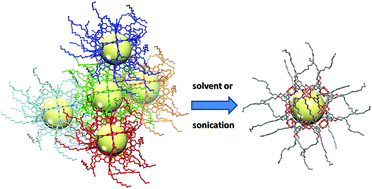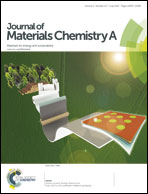Zero-periodic metal–organic material, organic polymer composites: tuning properties of methacrylate polymers via dispersion of dodecyloxy-decorated Cu-BDC nanoballs
Abstract
A self-assembled metal–organic polyhedron (i.e., MOP or nanoball) with –OC12 external/surface functionality has been incorporated into two polymeric systems: poly(2-hydroxyethyl methacrylate) (PHEMA) and poly(methyl methacrylate) (PMMA). The nanoball, having the chemical formula [(DMSO) (MeOH)Cu2(5-(dodecyloxy)-1,3-benzenedicarboxylate)2]12, possesses 24 saturated 12-carbon chains on the surface. This work characterizes the interactions between OC12-decorated nanoballs and the polymers, revealing interesting effects from the polymer perspective. The resultant nanocomposites were characterized by differential scanning calorimetry (DSC) and microindentation. The dielectric permittivity (ε′) and loss factor (ε′′) were measured via dielectric analysis (DEA) in the frequency range 1 Hz to 100 kHz. The electric modulus formalism was used to reveal α, β, γ and conductivity relaxations. The nanoball interactions with the different polymer matrices allows for tuning of mechanical and electrical properties, by varying polymer structure and/or nanoball loadings, which could be of interest in applications related to electrochemistry, implantable polymeric sensors, drug delivery, energy storage, and beyond.


 Please wait while we load your content...
Please wait while we load your content...